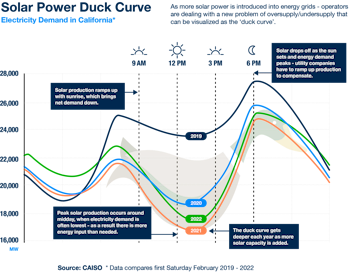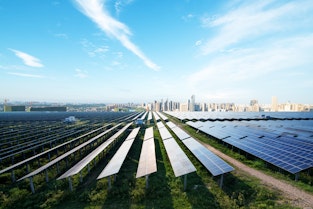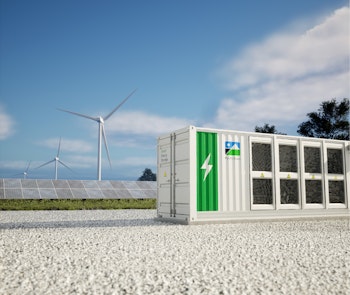There is controversy about when it was identified and named—but it is generally agreed that the duck curve represents a growing challenge to utilities.
It is also acknowledged that its appearance signals that in some markets at least, solar electricity generation has ceased to be a niche activity and has joined the energy mainstream. But what is the duck curve, and why is it important?
The duck curve is a snapshot of net electricity load over a 24-hour period in California during springtime, but it can be applied to a growing number of territories and circumstances.

The resulting curve somewhat resembles a well-known waterfowl, particularly if the curves from various years—representing growing increments of solar on the grid—are superimposed.
The duck curve shows net load rising slightly in the morning before solar-generated electricity floods the market and causes net energy demand to significantly drop around midday.
In the evening, though, net load rises sharply because solar generation falls off and electricity demand for air conditioning kicks in. The peak of demand happens around 9pm.
As solar generation has grown in California, so has the difference between the midday trough and the evening peak.
In 2020, the difference was of the order of 14 GW, putting immense strain on the grid and generation assets tasked with taking over when solar falls out of the mix.
Although it is originally attributed to US researchers at the National Renewable Energy Laboratory in 2008, the duck curve rose to prominence when the California Independent System Operator (CAISO) published an iconic chart illustrating the effect.

In Hawaii, significant adoption of solar generation has led to an even more pronounced curve known as the Nessie curve. To create the effects that result in the duck curve, PV must have a significant presence in the energy mix.
As CAISO has found, this creates a challenge for utilities in balancing supply and demand on the grid. Electricity generation must quickly ramp up when the sun sets and the contribution from PV falls.
Another challenge with high solar adoption is over-generation, leading system operators to curtail PV generation to avoid overloads and damage to the grid.
This reduces the economic and environmental benefits of solar, potentially reducing the impact of greater PV penetration levels. The obvious answer is to store some of the excess solar power produced during the day for use in tackling the evening peak.
That is what CAISO is doing.
In an interview with Energy Storage News, Gabe Murtaugh, storage sector manager for CAISO, explained that energy storage is now regularly shifting as much as 6 GWh of energy from low-price periods in the middle parts of the day to high-price periods later in the day.
CAISO’s utility-scale battery energy storage systems (BESS) are expected to grow to 4 GW this summer. But that is still not enough to avoid the use of non-renewables to deal with evening ramp-ups in demand.
Load shifting is mostly to high-polluting gas resources, Murtaugh explains.
“There are some periods of overproduction of renewables and storage is certainly absorbing some of that energy, but there will be some transition years before storage is charging primarily from renewable resources,” he says.
If California is to reach its goal of carbon-free electricity generation by 2045, increased use of battery energy storage is sure to play a major part.

According to one analysis, California will need to install almost 49 GW of energy storage—five times the output of all utility-scale batteries currently operating worldwide—to meet that target.
Lawmakers in the US Congress introduced legislation in March 2021 to create a tax credit for residential and utility-scale energy storage projects. This will help support the expansion of BESS projects and renewable energy systems across the country.
Even so, the battery storage requirements for California are so vast that a larger-scale storage solution might be required.
Instead of turning sunlight straight into electricity via PV, concentrated solar power (CSP) captures the heat of the sun and stores it in a medium such as molten salt, which is inexpensive and can be kept in huge tanks.
Several CSP plants around the world are already capable of delivering hundreds of megawatts of energy overnight and the technology is perfectly mature. Plus, CSP works well with PV in a hybrid plant setup.
In such plants, part of the installation is devoted to PV panels that deliver low-cost energy during the day. Another part of the plant has a solar field full of heliostats that heat up molten salt.
The output from the hybrid plant switches from the PV panels to a steam turbine driven by the heat of the molten salt as the sun goes down.
Although the generation processes are different, the hybrid setup benefits from having a single grid connection and balance of plant, which helps to reduce the overall cost. Another benefit is that the design of the plant can be calibrated to meet given market requirements.
While it remains to be seen whether CSP can play a role in addressing demand curves in markets such as California, the outlook for BESS is bright. BESS is a worthwhile addition to the grid for reasons which go beyond smoothing the duck curve.
It can act as an emergency backup, as happened during the Oregon Bootleg wildfire in July 2021. Then, CAISO’s batteries despatched around 1 GW to help keep the lights on after three transmission lines failed.
Plus, BESS can help the grid with a range of value-added services, such as providing frequency response or voltage control. These services are increasingly important in almost all grids around the world, and not just high-solar markets such as California.
In the UK, for example, Pacific Green has been ramping up investment in large scale-energy storage in projects such as the Richborough Energy Park battery development.
We combine European engineering, procurement and construction expertise with high-quality supply chains to deliver scalable and cost-effective battery projects—whether they are needed to deal with an emerging duck curve or for any other application.
To find out more, contact us now.
Publish date: 25 October, 2022